
Control techniques using herbicides
Herbicides are commonly used for controlling weeds in agricultural and non-agricultural situations, and there are many types of equipment and techniques available for applying them. The appropriate option will be determined by the size of the infestation, the available resources, access and personal preferences. The most commonly used application techniques are listed and described below. Always remember to read the product label and any relevant permit before using a herbicide.
Foliar spraying
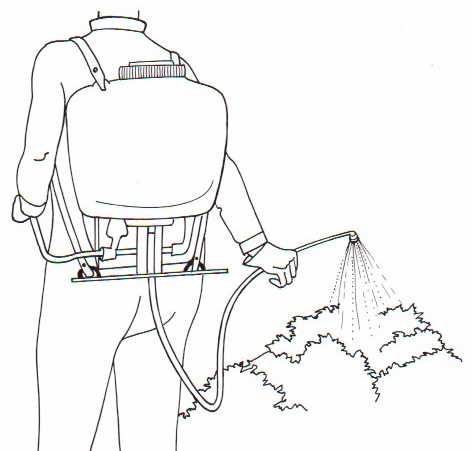
Foliar spraying is the use of herbicide diluted with water at a specific rate, and sprayed over the foliage to the point of runoff (until every leaf is wetted, but not dripping).
It is suitable for shrubs, grasses and dense vines where complete coverage can be achieved. Advantages include speed of application and economy. Disadvantages include the potential for spray drift and off-target damage.
Foliar spraying can be done a number of ways, depending on the size of the weed plant and/or the infestation. Blanket spraying using a boom spray mounted on a vehicle can be used to treat large areas with infestations up to 1 m in height. Taller infestations or those with difficult access can be sprayed with a handgun connected by a hose to a herbicide tank and pump, carried by a tractor or vehicle. Smaller infestations can be sprayed using a backpack/knapsack spray unit. Spot spraying is treating individual weed plants, areas that have only small clumps of weed infestations, or regrowth areas.
Gas gun/splatter gun
Gas guns or splatter guns apply a low volume of high concentration, translocatable herbicide to the foliage of an infestation (generally woody weeds). The herbicide is squirted from a gas-powered gun, placing very large droplets onto the leaves from 6–10 m away. The splatter is arched over the tops of bushes and down their sides, at specific intervals (refer to product labels for exact rates). Only a small portion of the foliage needs to be treated minimising off-target damage and reducing chemical usage. This technique allows for specific targeting of the herbicide and a marker dye is necessary to identify treated areas.
Rope/wick applicators
A wick or rope is soaked in herbicide that is pumped from a reservoir (either by hand or with 12-volt equipment). The wetted wick is used to wipe or brush herbicide over the weeds. Commercially available equipment such as Weed Wand and Weed Wiper are available in sizes ranging from hand-held to vehicle- or tractor-mounted.
It is sometimes necessary to provide some resistance for the wiper when the weed leaf or stem is soft. Stem swiping involves using a knife to provide resistance down the back of the stem or leaf, while manually wiping herbicide down the front.
Basal bark spraying
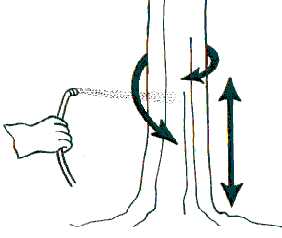
An oil-soluble herbicide is mixed with diesel and sprayed around the full circumference of the trunk or stem of the plant. It works for plants with basal diameters up to 10 cm and heights of 30 to 100 cm (check herbicide product labels as some plants can only be treated if their basal diameter is less than 5 cm). The diesel helps move the herbicide through the bark and into the underground storage organs of the plant, slowly killing it.
The whole circumference of the stem or trunk must be sprayed or painted with herbicide solution from ground level to a height of 30 cm. It is important to saturate the full circumference of the trunk, and to treat every stem or trunk arising from the ground.
Basal bark spraying is suitable for thin-barked woody weeds and undesirable trees, and is also an effective way to treat saplings, regrowth and multi-stemmed shrubs and weeds in inaccessible areas such as steep banks. It creates little or no spray drift or off-target damage, and will usually control difficult-to-kill weeds at any time of the year, as long as the bark is not wet or too thick for the diesel to penetrate.
Stem injection methods
Herbicide is placed immediately into holes or cuts made by drilling or cutting through the bark into the sapwood tissue in the trunks of woody weeds and trees. The aim is to reach the sapwood layer just under the bark (the cambium), where the chemical will be transported throughout the plant.
It is essential to apply the herbicide immediately (within 15 seconds of drilling the hole or cutting the trunk), as stem injection relies on the active uptake and growth of the plant to move the chemical through its tissues.
Stem injection methods kill the tree or shrub where it stands, and only trees and shrubs that can be safely left to die and rot should be treated this way. If the tree or shrub is to be felled, allow it to die completely before felling.
Stem injection - drill and fill method
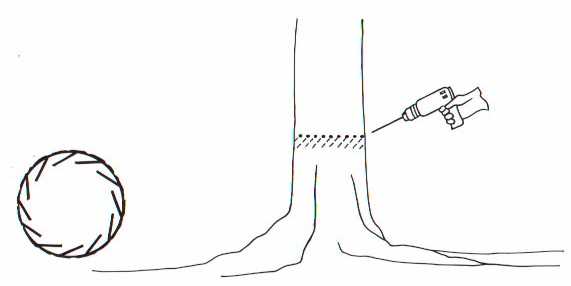
This method is for trees and woody weeds with stems or trunks greater than 5 cm in circumference. A battery-powered drill is used to make downward-angled holes in the sapwood approximately 5 cm apart. Herbicide is then injected in measured doses using a backpack reservoir and syringe.
Stem injection - axe cut method
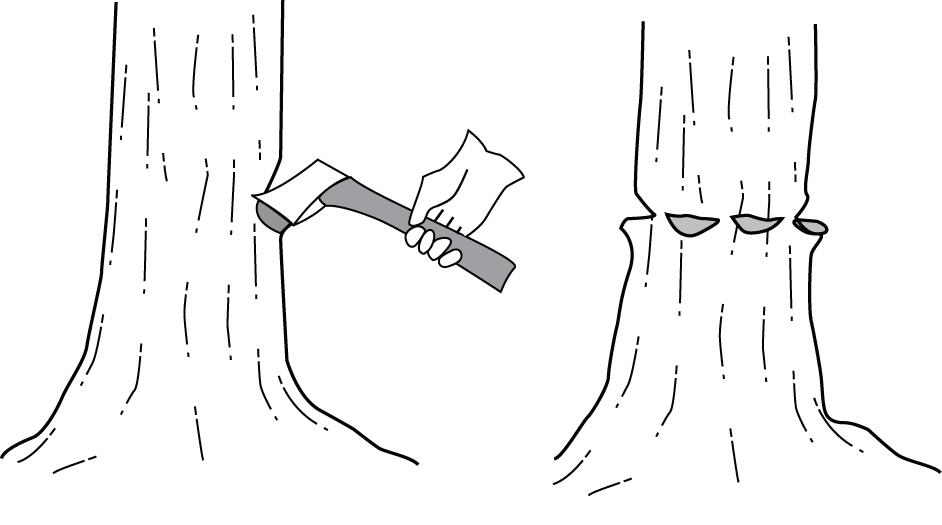
The axe cut method can be used for trees and woody weeds with stems or trunks greater than 5 cm in circumference. Using an axe or tomahawk, horizontal cuts are made into the sapwood around the circumference of the trunk at waist height. While still in the cut, the axe or tomahawk is leaned out to make a downward angled pocket, which will allow herbicide to pool. The herbicide is then immediately injected into the pocket. Cuts should be made no farther than 3 cm apart. This method is also referred to as frilling or chipping.
It is important not to entirely ringbark the trunk, as this will decrease the uptake of the herbicide into the plant.
Tree spearing
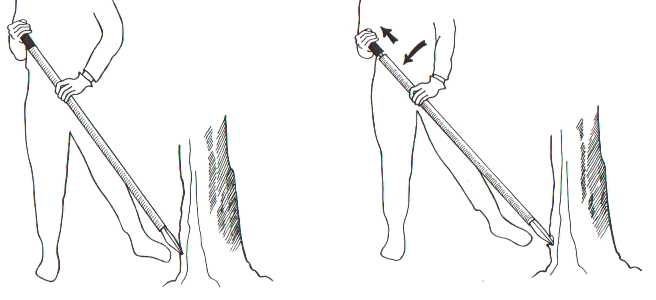
Tree spearing is an alternative stem injection method to the use of an axe or drill. The method uses a specifically designed tree spear and technique. The spear is thrust into the tree at an angle of 30° to 40° from the vertical, opening a cut in the tree and applying the appropriate herbicide amount. The process is repeated, forming a row of cuts approximately 50 mm apart.
Cut stump
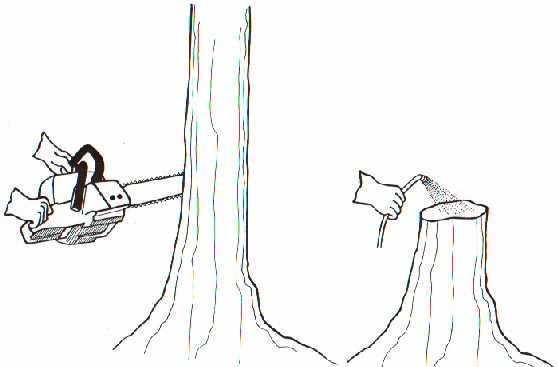
Here the plant is cut off completely at its base (no higher than 15 cm from the ground) using a chainsaw, axe, brushcutter or machete (depending on the thickness of the stem/trunk). Herbicide is then sprayed, squirted or painted on to the exposed surface of the cut stump emerging from the ground, killing the stump and the root system.
It is imperative that the herbicide solution is applied as soon as the trunk or stem is cut. A delay of more than 15 seconds between cutting and applying the chemical will give poor results. Two operators working as a team can use this method effectively. The herbicide can be applied from a knapsack, or with a paintbrush, drench gun or a hand spray bottle. A coloured dye should be used in the solution to mark the stumps that have been treated.
This method has the appeal of removing the weed immediately, and is used mainly for trees and woody weeds.
Cut and swab
This method is similar to the cut stump method, but is suited to vines and multi-stemmed shrubs. Here, the plant stems are cut through completely, close to the ground. Herbicide is then applied immediately to the cut surface emerging from the ground, via spray or brush application.
In the case of Madeira vine and some other vines with aerial tubers, both ends of the cut stems must be treated with herbicide.
Stem-scraping
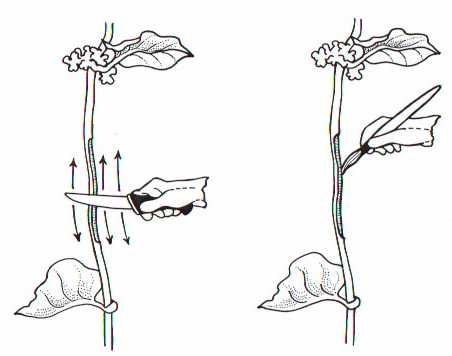
This method is also called bark-stripping or stem-painting. Stem-scraping is used for plants and vines with aerial tubers. A sharp knife is used to scrape a very thin layer of bark from a 15–30 cm section of the stem. Herbicide is then immediately applied to the exposed soft underlying green tissue. In the case of Madeira vine, all tubers within reach should be collected, removed and composted or destroyed before starting the scraping.
With some woody weeds the bark can be peeled away and the exposed wood painted or sprayed with herbicide.
Line Drawings by Lyn Skillings.

